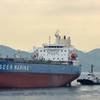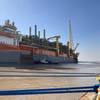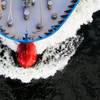Larry Wieber's Aluminum Chambered Boats Inc. (ACB) has maintained a low profile during its first four years of operation. With a growing demand for security craft, and ACB's stellar performances in front of government buyers, his company's success is now Bellingham, Washington's worst kept secret.
by Greg Trauthwein
Personal sacrifice and pain often accompany success. Larry Wieber never knew the pain part would be literal, not figurative.
In the process of helping a television production company prepare a story on his unique craft before bad weather stopped filming, Wieber badly crushed one of his fingers while rolling one of his boats off its trailer. Unwilling to lose the invaluable national exposure afforded by a Ship Shape TV spot, Wieber discovered yet another use for versatile duct tape, supported the crushed appendage and proceeding with the show.
Earning the respect (and coverage) of Ship Shape TV host John Geveskis that day was one of the primary steps in ACB earning the respect (and business) of customers across the U.S.
Wieber's ACB is well positioned to capitalize on the current and projected future spending spree by the U.S. government to shore up port, coastline and inland waterway security. As homeland security plans and funding still take shape, it is impossible to gauge the depth or breadth of the impact on small boatbuilders across the nation.
"There's a lot of jockeying for position right now," said Wieber. "With FEMA taking an active part in homeland security, there will be a lot of money funneled to local police and sheriff departments." Thus, demand will be high for a lot of 23 to 26 ft. trailerable boats, creating a highly mobile fleet able to be marshaled in a hurry.
"There is quite a large amount of money available for small boat procurement" for both the Navy and Coast Guard, according to Rob Neal, a spokesman for U.S. Representative George Nethercutt (R-Spokane). For the Navy alone, the budget for the procurement of small boats more than tripled from $12.6 million in FY '01 to $37.3 million in FY '02. President Bush's Budget Request for FY '03 includes $33.6 million for Navy small boat procurement. Congressman Nethercutt was instrumental in introducing ACB technology to the Navy, and being that he is Vice Chairman for Defense Appropriations, he was the right man for the job.
The ACB Alternative
Aluminum Chambered Boat was established by Wieber - a self-described "boat junkie" - in a 30,000-sq. ft. facility in Bellingham four years ago. The origin of the design comes from New Zealand company, Stabi-Craft.
At first, Wieber envisioned a plan to license and sell the Stabi-Craft boats in the U.S., however he said the Stabi-Craft method of production depends largely on "hand-crafted" solutions, which would essentially make the vessels too expensive and unmarketable for mass production and distribution in the U.S.
He and Bill Hickok, ACB operations manager and a production specialist, spent much time devising a reasonable, systematic and standardized production process (patent-pending) for building high quality boats at a lower cost. He has settled on a method that depends on the in-house production and outside supply of airtight aluminum chambers (made from marine grade 5052 aluminum) that create the critical "lifejacket" collar for the boat. The pre-bent, pre-cut aluminum chambers are then set in place and individually tested.
The flexibility of the ACB boat is embodied in its wide variety of applications, from recreational craft to heavy duty commercial workboat to military and patrol craft. One high-profile ACB owner is Jean-Michel Cousteau, who chose an ACB 2600 with twin 150-hp Evinrude outboards for work with the Ocean Futures Society.
Despite the operational and performance value of the ACB design, outstanding testimonials from mostly local recreational and commercial owners, and a smattering of high-profile placements, the company remained largely under the radar scope of the national marine market.
That all changed about two years ago.
While in San Diego for a recreational boat show, Wieber was engaged in a conversation with a "consumer" regarding the boats characteristics and performance. Unknown to him at first was that the man was with the U.S. Navy Pacific Fleet Command, and was investigating solutions to integrate new small boats for patrol missions.
In August 2001 ACB had ready for testing a prototype vessel for the Navy, a test which was covered by local television and viewed by a U.S. Border Patrol official, which led to yet another inquiry. Meanwhile, Wieber credits Congressman George Nethercutt (R-Spokane) of having information on the boats put before the Navy. According to Rob Neal, a spokesman for Nethercutt, the Congressman jumped onboard an ACB earlier this year for a test ride and immediately became aware of the boats potential for use in military and harbor patrol capacities. Neal said his office regularly works with small companies in Washington State — small companies without large lobbying dollars — to introduce them to decision makers in Washington. "We made the initial contact and delivered a video, but the boat sold itself," Neal said. That point was obvious, as just two days after viewing the tape Wieber received a call from NAVSEA saying "We are very, very interested in your boats … where have you been hiding? We are coming to see you."
With the market and funding for his type of boats essentially established with the events of September 11 and the aftermath, Wieber feels well-positioned to capitalize. "Sometimes I just have to pinch myself," Wieber said, noting the tremendous amount of attention from local, regional and national interests, as well as the positive feeling from a pre-July 4 meeting with a group of potential investors. "We are very actively searching for (new production) sites for expansion, in and around Washington," he said, noting that any new facility would have to be "ready to roll," indicating the imminence of new contracts to come.
Why ACB?
Aluminum Chambered Boats, according to Larry Wieber, offer many advantages over competitive designs, such as:
Smooth ride
Lightweight aluminum, 38 degree deadrise at point of entry and 18 percent deadrise at the transom, 2.5-in. reverse chine and tapered beam all work in concert to ensure that ACB offer an exceptionally smooth ride in both good and bad conditions. The company reports the ability to regularly cruise through two to three ft. chop at 35 to 45 mph.
Power to weight ratio
Light weight aluminum construction plus induced lift offer higher speeds, and good fuel efficiency with lower horsepower. The ACB hits planing speed at 12 mph, and 270 hp is all that is need to push the 2600 Rescue Pro to more than 50 mph.
Low maintenance
The aluminum hull does not require frequent repairs, and if an impact is substantial enough to puncture a chamber, the boat is designed to be easily repaired in minutes by a competent welder. In a company-produced video a boat is dropped from 30 feet, drilled full of holes and thrown off a jetty. The boat floated with no ingress of water, and was reportedly repaired in about an hour and a half.
Unsinkable
The tough aluminum construction combines with a multi-chambered buoyancy system to offer an unsinkable design. Floatation is achieved without foam, and the ACB is reportedly the first boat to pass USCG Certification for boats 20 ft. and under without the use of foam.
Subscribe for
Maritime Reporter E-News
Maritime Reporter E-News is the maritime industry's largest circulation and most authoritative ENews Service, delivered to your Email five times per week












